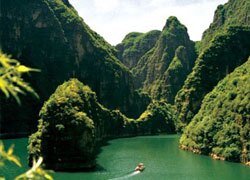Yangtze River Legends
Yangtze River is greatly honored as being the cradle for Chinese civilization. In China, it is the longest river and listed as the third longest river in the world. Today, it is the most economically prosperous and densely populated area in China. With its long history, Yangtze River also has splendid culture and a lot of legends and myths surrounding the river and the entire region as highlighted here below:
Legend of Dragon Boat Race & Eating Zongzi
 The Chinese people eat Zongzi during Dragon Boat Festival every year. Zongzi refers to the glutinous pyramid shaped rice that is wrapped in bamboo or reed leaves. During the festival, dragon boat races are held as a custom for commemorating Qu Yuan. In Qu Yuan hometown, there is a very popular legend that explains this custom.
The Chinese people eat Zongzi during Dragon Boat Festival every year. Zongzi refers to the glutinous pyramid shaped rice that is wrapped in bamboo or reed leaves. During the festival, dragon boat races are held as a custom for commemorating Qu Yuan. In Qu Yuan hometown, there is a very popular legend that explains this custom.
The legend goes that after Qu Yuan had drowned himself in River Miluo, there was a man in his hometown who dreamt about him. In the dream, when Qu Yuan was drowning himself, he appeared very sad. Upon seeing him, all his fellow villagers gave him a salute. When returning their salute, he thanked his fellow villagers for the great love and esteem they had shown towards him. A villager noted that Qu Yuan was actually in poor healthy.
He thus asked him if he had consumed the rice that villagers dropped in the river. Qu Yuan thanked the villagers for their efforts but told them that aquatic animals, including the shrimps and fish had eaten all the rice they threw in the river. The villagers were very roily when they heard this and asked how they could ensure the fish didn’t eat the rice they had sent him.
After sighing, Qu Yuan asked the villagers to wrap the rice in pyramid shapes using bamboo or reed leaves. This way, the aquatic animals would think that the rice is just waster chestnut which they wouldn’t eat. Doing according to what Qu Yuan had suggested to them, villagers dropped pyramid shaped rice during the next festival. However, Qu Yuan said that he had just eaten little of it and the fish ate the bigger share.
To solve the problem, Qu Yuan advised the villagers to add pictures of dragon to the food and beat drums as they rowed their boats. This way, the fish will think the food belongs to the king which they would not dare eat as commanded by the king.
Come to me
Kongling Shoal is found along the Yangtze River. During the season of low water, a rock that has three characters is visible, which means come to me. Since Kongkling Shoal is a place of swift rapids and submerged reefs, many ships and boats have ended up crashing on the rock. Normally, if a boat man sees the rock and rapids, he avoids hitting the rock which makes the boat to crash on it.
Later experienced boatmen realized that for them to avoid hitting the rock and pass it safely; they were supposed to aim at the rock directly. As a result, the rock was named ‘come to me’. A boat can safely maneuver between these rocks due to regurgitant thrust.
A German ship was passing Kongling Shoal in 1900. As he met the turbulent wave and dangerous wave, the captain of the ship was highly panic stricken. He was unable to find a way out and asked a Chinese man in the ship to take charge of steering the ship. Since the man was very familiar about what it called for to pass the dangerous rock, he aimed the ship directly to the rock.
The captain thought that the Chinese man was planning to kill them by destroying the ship and thus tried to steer the ship away from the rock. As a result, he crashed the ship and submerged it into the river. For about nine years this accident led to the stopping of shipping activities along Three Gorges Section.
The Legend of Yinwotan
 Yinwotan is a very dangerous shore seen as one enters Daning River. Locals refer to it as Silver Nest Shoal. The legend says that 90 percent of ships trying to pass the shoal end up sinking. The area got its name as a result of the many rich men in ancient times who took treasures and money while passing through the shoal. As the ships overturned, they dropped many golden and silver treasures in the water.
Yinwotan is a very dangerous shore seen as one enters Daning River. Locals refer to it as Silver Nest Shoal. The legend says that 90 percent of ships trying to pass the shoal end up sinking. The area got its name as a result of the many rich men in ancient times who took treasures and money while passing through the shoal. As the ships overturned, they dropped many golden and silver treasures in the water.
According to the legend, a boy named Silver Dragon/ Yin Long lived near the shoal. His parents had died when he was only ten years old. The boy helped his boss who owned a boat. One day, Yin Long was told to steer a boat from the county of Dachang to Wushan by the boss’s avaricious relative. This relative was quite rich and was boastful about his treasure as he used silver chopsticks, plates and cups on the boat.
As the ship passed through Longmen Gorge, there were many very dangerous shoals that made the boat to wobble. In response, the silver vessels which the man had been using tipped into the river.
According to the rich man, he thought Yin Long disturbed the vessel intentionally and had him beaten. The beating resulted in the boy being thrown into the sand and as he groaned, the dragon prince came.
The prince shows that Yin Long was in great danger and he gave him some precious pearl, which delivered anything he asked. Yin Long took the pearl home and asked it for clothes and food which he distributed to poor people. When the man heard of the precious pearl, he sent his men to catch the boy. Yin Long then asked the men to untie him for a while. He ran towards a gorge.
As the man’s servants together with the rich man came to catch him at the gorge, he changed into a huge dragon. He rolled them into Daning River where they all drowned. Yin Long continued to create waves at Silver Nest Shoal that crashed the boats of rich men passing there. As a result, a large number of rich men along with their treasure have been buried in river Danning. According to the legend, after Yin Long shows that greedy men no longer existed, he ceased causing trouble at the Shoal which is now safe.
Legend of Goddess Peak
 Among the twelve peaks found in Wu Gorge, the most significant peak is the Goddess peak. The locals have many legends about this particular peak. The Goddess Peak is quite beautiful and stands gracefully on the northern bank of Yangtze River. Of the twelve peaks, Goddess peak actually the highest peak and it is the first peak that greets the sun’s glow everyday. For this reason, it is also known as Wangxia Peak, which is translated to mean looking sunglow peak.
Among the twelve peaks found in Wu Gorge, the most significant peak is the Goddess peak. The locals have many legends about this particular peak. The Goddess Peak is quite beautiful and stands gracefully on the northern bank of Yangtze River. Of the twelve peaks, Goddess peak actually the highest peak and it is the first peak that greets the sun’s glow everyday. For this reason, it is also known as Wangxia Peak, which is translated to mean looking sunglow peak.
Since ancient times, the locals have come up with numerous legends regarding Goddess Peak. One of the most popular says that during prehistoric times, the heaven palace had many fairies. Yao Jin was a very beautiful and clever fairy who lived at the palace. On Mid- Autumn Festival, Yao Jin requested her sisters to visit earthly world. She is believed to have felt quite lonely in heaven.
After arriving at Wu Gorge, her sisters show that Yu the Great controlled flooding at the Gorge. Yao Ji was greatly moved by his spirit and sent Yu the Great a book about controlling the flooding.
However, Yao Ji was caught by heaven soldiers and tied in chains. Her sisters broke the chain and the twelve of them returned to earth. They helped in overcoming the flood and they decide to stay at Three Gorges Area in order to help locals tame the water. As such, they never returned to heaven and they became the twelve Wu Gorge peaks. Yao Ji is believed to be incarnated by Shennu peak.
The below themes also speak Yangtze Culture:



